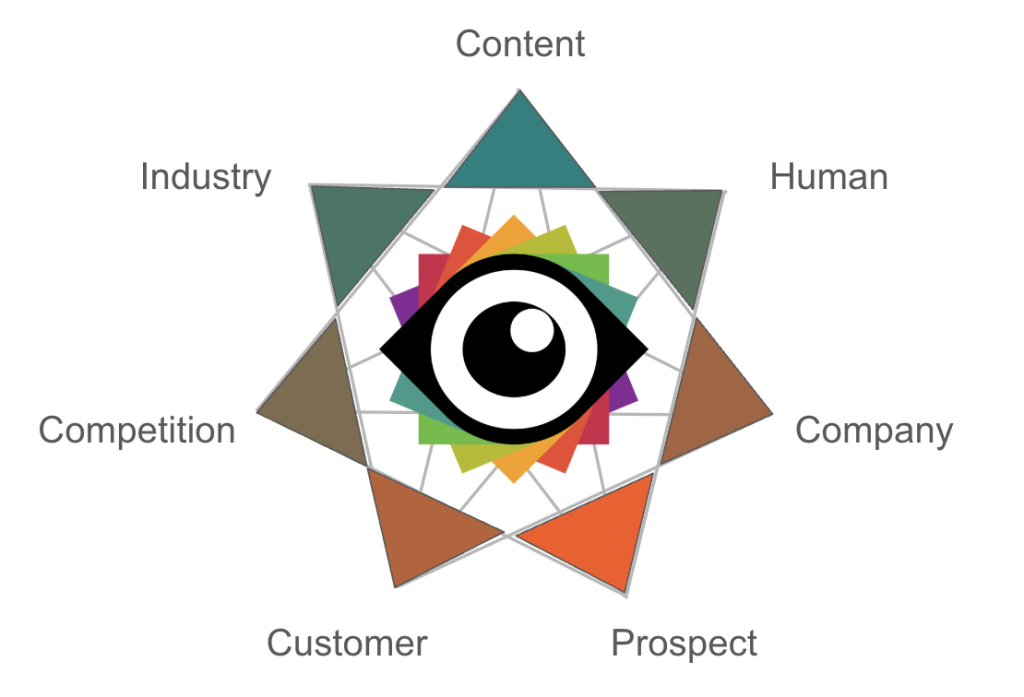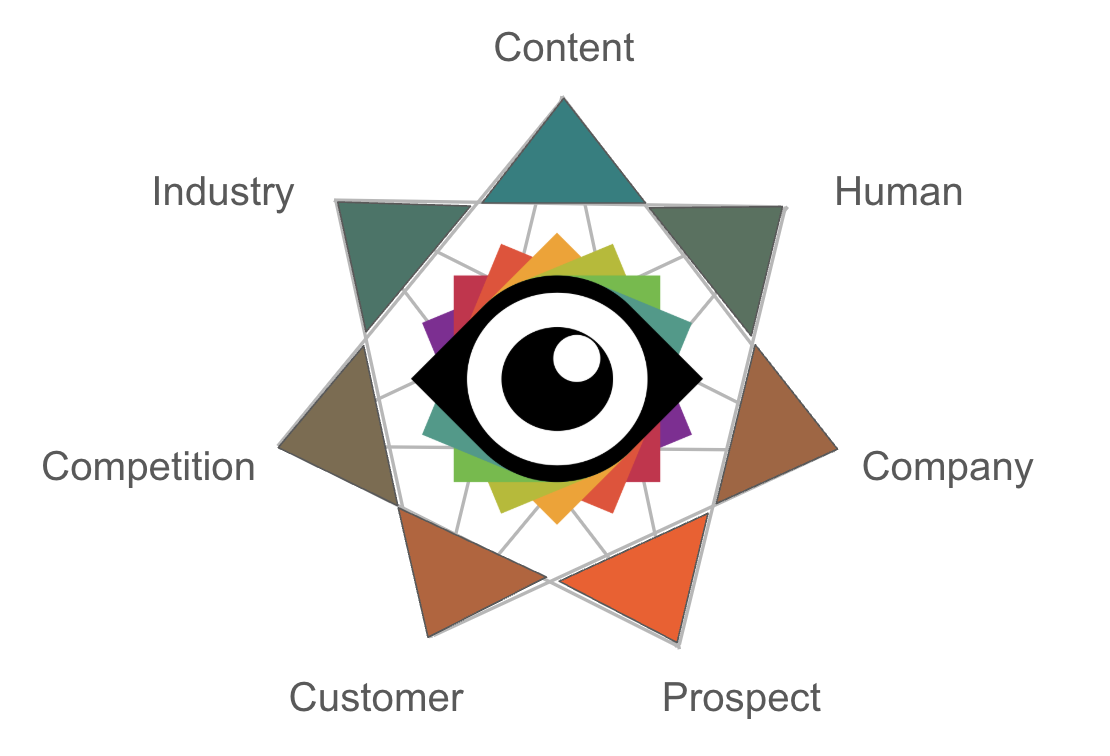Why are there seven content perspectives?
I recently posted an article about using ChatGPT to generate hex RGB values for a 7-step color gradient circle. Yes, I’m that interesting. But the main question I got afterward was: Why does content have seven perspectives anyway, Steve? Aren’t you just complicating things?
The answer? No, honest! It’s just that I’ve seen this pattern repeatedly over years of creating and commissioning content, and through discussion with all kinds of partners and clients.
I hope this helps you in some small way…
The Purpose of the Seven Content Perspectives
Content is often created from one person’s perspective directed at another.
A typical example: I’m the CEO, and I’m writing for a prospect.
But in reality, there are multiple other perspectives involved—often without us realizing it.
For example, if the writer talks to a sales person, or subject matter expert, or a customer, then the tale suddenly takes a twist.
When you miss one of these key perspectives, your content is like a car missing a wheel. Sure, it might move, but not efficiently or effectively.
However, I’m not saying that every piece of content needs to explicitly touch all seven perspectives: what I’m saying is that awareness of all these perspectives, with information to hand, helps enrich any discussion or content between two people.
Let me explain. But first, the infographic!

What is it?
Here’s a real-world example of how content flows through multiple perspectives in a business setting:
- Steve (Human) creates a
- Battlecard (Content) with
- John in Sales (Human) for
- Acme Corp (Company) that references
- Wile E Coyote Corp (Competition) using a
- Case study (Content) based on
- Wash and Go (Customer) and
- Research (Industry) to help
- Joe Blow Inc (Prospect).
Every piece of content you create likely touches on multiple perspectives without you realizing it. Experienced content folks inherently know this. Recognizing and addressing all seven ensures your message resonates and achieves its goal.
What’s the point?
You can start content creation from any of these seven perspectives, but great content touches all of them. Here’s how you can approach it:
Example: You want to write a white paper about your widget. Where do you start?
- From the Human perspective: How does your product help Joe Blow hit his targets, get promoted, or buy that dream boat?
- From the Prospect’s perspective: What problem do they have? How does your solution fit?
- From the Competition’s perspective: How do you compare to alternatives, including DIY solutions?
What can I do about it?
Whether you’re asking for, commissioning, collaborating on, or delivering content — if you want to create more effective content, use this framework as a checklist.
Ask yourself — and while this sounds “boring”, it’s good stuff:
- Am I addressing my target audience’s perspective? Who is Dear Reader? It’s not your CEO.
- Have I considered my company’s messaging? Have we said/learned this before?
- How does my competition frame this topic?
- Do I have strong supporting examples (case studies, research)?
- What role does my customer’s experience play in this story?
Do this when you “ideate”, when you do your brief and outline, when you draft, and when you review/edit.
I promise you’ll get more ideas and great stuff from using this framework. But do you want a cheat code?
Cheat code: Prompting an LLM with the seven content perspectives
We’ll use Google Gemini for change here, but try this with multiple LLMs. Claude is particularly good for these things.
How to prompt engineer for the seven content perspectives.
Large Language Models (LLMs) like Gemini can be powerful tools for content creation, but they work best when given clear direction.
The seven content perspectives framework provides an excellent structure for collaborating with an LLM. Here’s a suggested approach:
- Create your original idea or brief for the article.
Start with your core concept and any initial research or thoughts. This gives the LLM a solid foundation to build upon. - Prompt engineer into Gemini and collaborate with it to create more ideas, or an outline, or a draft.
For example, you could provide Gemini with your initial brief and then ask it to: “Analyze this brief from the perspective of each of the seven content perspectives (Human, Prospect, Company, Competition, Customer, Industry, Content).
Generate new ideas or angles for the article based on these different viewpoints.” Or, after generating a draft, you could prompt: “Review this draft. How could the perspectives of the Competition and the Customer be further emphasized to strengthen the argument?”
By explicitly referencing the seven perspectives in your prompts, you can guide the LLM to generate more nuanced and comprehensive content. This collaborative approach allows you to leverage the LLM’s capabilities while ensuring the final output aligns with your overall content strategy.
Here’s an example of a prompt, and the output.
Example prompt
## Content Exploration Prompt: The Future of Team Collaboration in a Remote-First World
**Original Idea:** The increasing prevalence of remote work is changing the dynamics of team collaboration.
**Framework 1: The 7 Content Perspectives (Human, Prospect/Audience, Company, Competition, Customer, Industry, Content)**
* **Human:** How do remote team members experience collaboration? What are their pain points and preferences?
* **Prospect/Audience:** Who are we creating this content for? What are their needs and interests related to remote collaboration?
* **Company:** How can companies adapt their strategies and tools to facilitate effective remote collaboration?
* **Competition:** What are other companies doing in this space? What are the best practices and emerging trends?
* **Customer:** How does remote collaboration impact the customer experience?
* **Industry:** What are the broader societal and technological trends shaping the future of remote collaboration?
* **Content:** What types of content (e.g., articles, case studies, webinars) would be most valuable for exploring this topic?
**Framework 2: SWOT Analysis (Strengths, Weaknesses, Opportunities, Threats) Applied to Remote Collaboration**
* **Strengths:** What are the inherent advantages of remote collaboration?
* **Weaknesses:** What are the challenges and limitations of remote collaboration?
* **Opportunities:** What are the potential benefits and possibilities that remote collaboration unlocks?
* **Threats:** What are the risks and obstacles that remote collaboration poses?
**Task:**
**Task:**
1. Analyze the original idea through the lens of both the 7 Content Perspectives and the SWOT Analysis framework. While considering all perspectives, pay particular attention to the Human, Company, and Industry perspectives for this topic.
2. Generate three distinct content ideas (titles and brief descriptions) that explore the future of team collaboration in a remote-first world. Each idea should address at least 3 of the 7 Content Perspectives and consider elements of the SWOT analysis. Aim for approximately 50-75 words per description.
3. For ONE of the generated content ideas, create a detailed outline, including key topics, subtopics, and potential supporting evidence. Provide examples of the *types* of supporting evidence that would be relevant, such as statistics on remote work adoption, case studies of successful remote teams, or expert quotes on the future of work.
**Desired Output Format:**
* **Content Idea 1:** [Title] - [Brief Description]
* **Content Idea 2:** [Title] - [Brief Description]
* **Content Idea 3:** [Title] - [Brief Description]
* **Detailed Outline (for chosen idea):** [Outline structure with key topics, subtopics, and supporting evidence]
**Note:** Consider the potential limitations of LLMs regarding factual accuracy and bias. The output should be reviewed and validated before being used.Response
You clearly wouldn’t just publish this, but it gives you another step down the path and some ideas on how you can develop the idea. Next, I would do some human work on this, potentially put this through a Research or Reasoning LLM, and work out what content is viable. I would create a synopsis (library of!) and share this will colleagues to see what is a priority / most value.
Analysis through Frameworks:
7 Content Perspectives:
Human: Remote team members experience both increased flexibility and potential isolation. They may struggle with communication, work-life balance, and maintaining team cohesion. They need tools and strategies that foster connection and collaboration.
Prospect/Audience: This content is for business leaders, HR professionals, team managers, and remote workers themselves. They seek practical advice, best practices, and innovative solutions for effective remote collaboration.
Company: Companies must invest in the right technology, training, and processes to support remote teams. They need to redefine performance management and foster a culture of trust and communication.
Competition: The market for remote collaboration tools and services is booming. Companies are vying to offer the best solutions for virtual meetings, project management, and team communication.
Customer: Remote collaboration can impact customer service and product development. Companies need to ensure that remote teams are aligned with customer needs and can deliver seamless experiences.
Industry: The shift towards remote work is a major societal and technological trend. It's being driven by advancements in communication technology, changing workforce demographics, and a growing desire for work-life balance.
Content: Valuable content includes case studies, research reports, practical guides, webinars, and interactive tools.
SWOT Analysis:
Strengths: Increased flexibility, reduced overhead costs, access to a wider talent pool, improved work-life balance for some.
Weaknesses: Communication challenges, potential for isolation and loneliness, difficulty building trust and rapport, blurred work-life boundaries.
Opportunities: Increased productivity through asynchronous communication, innovation in remote collaboration tools, creation of more inclusive and diverse workplaces.
Threats: Cybersecurity risks, data breaches, difficulty maintaining company culture, potential for decreased employee engagement.
Content Ideas:
Content Idea 1: Bridging the Distance: A Practical Guide to Fostering Human Connection in Remote Teams - This guide explores the human side of remote collaboration, focusing on building trust, fostering empathy, and creating a sense of community. It addresses the challenges of isolation and communication breakdown, offering practical tips and strategies for team building, conflict resolution, and maintaining work-life balance. It considers the needs of both individual team members and the company as a whole, looking at how company culture can be adapted for a remote-first world.
Content Idea 2: The Remote Revolution: How Companies are Thriving in the New World of Work - This research report examines how leading companies are successfully navigating the transition to remote work. It analyzes best practices in areas such as communication, project management, performance evaluation, and leadership development. It also looks at the impact of remote work on customer experience and explores the emerging technologies that are shaping the future of work. It considers the competitive landscape and the opportunities and threats that remote work presents for businesses.
Content Idea 3: Beyond the Buzzwords: A Realistic Look at the Future of Team Collaboration - This webinar brings together industry experts to discuss the long-term implications of remote work. It goes beyond the hype and explores the real challenges and opportunities that lie ahead. The discussion will cover topics such as the evolving role of technology, the changing nature of work, and the impact on society as a whole. It will address the human element, the industry trends, and the company's need to adapt.
Detailed Outline (for Content Idea 1):
Title: Bridging the Distance: A Practical Guide to Fostering Human Connection in Remote Teams
I. Introduction:
The rise of remote work: Setting the context (statistics on remote work adoption).
The importance of human connection in remote teams (expert quotes on the impact of isolation).
Overview of the guide's key themes.
II. Understanding the Challenges:
Communication barriers in remote settings (examples of common communication issues).
The impact of isolation and loneliness on remote workers (research on the psychological effects of remote work).
Difficulties in building trust and rapport remotely (case studies of successful and unsuccessful remote teams).
Blurred work-life boundaries (tips for managing work-life balance in a remote environment).
III. Building a Culture of Connection:
Strategies for effective communication (best practices for virtual meetings, asynchronous communication, and feedback).
Fostering a sense of community and belonging (examples of virtual team-building activities).
Promoting empathy and understanding within remote teams (techniques for active listening and conflict resolution).
Creating opportunities for social interaction (virtual coffee breaks, online social events).
IV. Empowering Remote Leaders:
The role of leadership in remote teams (characteristics of effective remote leaders).
Building trust and accountability in a remote environment (strategies for performance management and feedback).
Supporting the well-being of remote team members (resources and programs for mental health and stress management).
V. Tools and Technologies for Connection:
Overview of essential remote collaboration tools (video conferencing, project management software, communication platforms).
Leveraging technology to enhance communication and connection (examples of innovative uses of technology in remote teams).
Choosing the right tools for your team (factors to consider when selecting remote collaboration technology).
VI. Conclusion:
Key takeaways and action steps for building stronger remote teams.
The future of human connection in a remote-first world (expert predictions and trends).
Supporting Evidence Examples:
Statistics on remote work adoption from reputable sources (e.g., Gartner, Statista).
Case studies of successful remote teams from organizations like GitLab or Zapier.
Expert quotes on the future of work from thought leaders in the field.
Research on the psychological effects of remote work from academic journals.
Examples of innovative remote team-building activities and communication strategies.Final Thought
This isn’t about overcomplicating content—it’s about making it better. Whether you’re writing a blog post, a sales deck, or a case study, keeping these perspectives in mind will help you craft content that truly connects.
So, next time you sit down to create content, ask yourself: Am I seeing all seven perspectives?
Get in touch for a chat.

